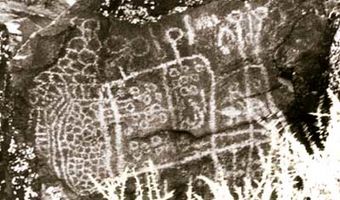Big and Little Petroglyph Canyons facts for kids
|
Big and Little Petroglyph Canyons
|
|

Ancient rock art by the Coso People
|
|
| Lua error in Module:Location_map at line 420: attempt to index field 'wikibase' (a nil value). | |
| Nearest city | China Lake, California |
|---|---|
| Area | Coso Rock Art District |
| Artists | Coso People |
| NRHP reference No. | 66000209 |
Quick facts for kids Significant dates |
|
| Added to NRHP | October 15, 1966 |
| Designated NHL | July 19, 1964 |
Big and Little Petroglyph Canyons are amazing places in the Coso Range Mountains of the Mojave Desert in California. These canyons are home to a huge collection of ancient rock art. This art was created by the Coso People, who were early Native Americans.
Today, these canyons are located inside the Naval Air Weapons Station China Lake. This is near the towns of China Lake and Ridgecrest, California. Little Petroglyph Canyon alone has over 20,000 recorded images. This makes it one of the largest collections of rock art anywhere. The sites are also very well-preserved.
What are the Coso Petroglyphs?
The Coso Petroglyphs are drawings carved into rock surfaces. Scientists have studied these carvings for a long time. They try to understand what the images mean and why they were made.
Some experts believe the drawings show visions from spiritual journeys. These journeys were often part of a shaman's (spiritual leader's) work. Other ideas suggest the art was part of a "hunting religion." This religion might have included special ceremonies. These ceremonies could have been to help increase the number of bighorn sheep.
It's possible that both ideas are partly true. The artists might have been spiritual leaders. Their messages could have been about honoring bighorn sheep.
Ancient Tools and Trade
The Coso People were not just artists. They also made many tools from a volcanic rock called obsidian. Obsidian is very sharp and was used for cutting tools.
Archaeologists have found lots of evidence of this tool-making. They also found proof that the Coso People traded these tools. They traded with other Indigenous peoples of the Americas tribes. For example, obsidian tools from the Coso area have been found far away. They were found at sites near the Pacific coast. This shows they traded with groups like the Chumash People.
Protecting These Historic Sites
Big and Little Petroglyph Canyons are very important. They are located on land belonging to the Naval Air Weapons Station China Lake. These two canyons are recognized as a U.S. National Historic Landmark. This means they are very special and protected.
In 2001, the canyons became part of an even bigger area. This larger area is called the Coso Rock Art District. It is also a National Historic Landmark.
To celebrate this amazing history, the Ridgecrest Petroglyph Festival was started in 2014. This annual event helps people learn about the petroglyphs. It also highlights the rich history of the area.

